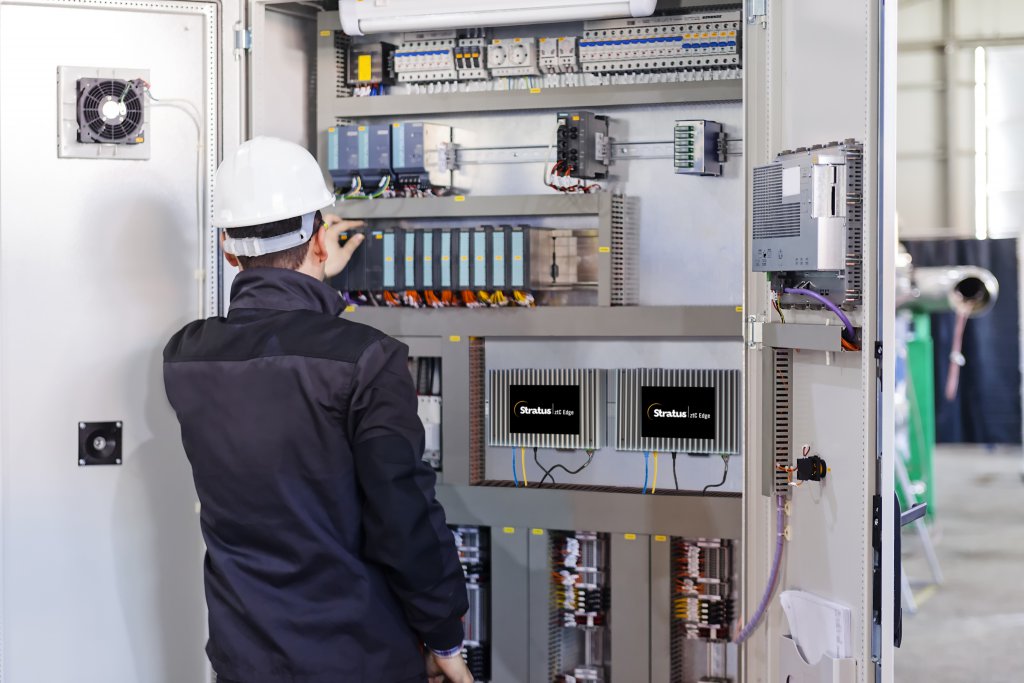
How ‘hard hat’ staff can deploy next-gen edge technology, with Stratus

Just a few years ago, the business technology press was full of predictions that soon, just about everything technology-related would be done in the cloud.
The phrase became a mantra, spurred on not least in part by technology service supplier and manufacturers all rushing to push their products cloud-wards. The attraction of an always-on, centrally-controlled collection of services, paid for on a pay-as-you-use basis, was undeniable, and in many settings, the cloud has become king.
After taking a closer look, it’s become clear that while cloud computing has many beneficial applications, it’s not the best answer to every use case. It’s probably not a good idea to start shutting down local and edge-based data centers and computing stacks just yet. Edge computing also has challenges that need to be taken into consideration in order to optimize performance.
Take the security issues and costs of an edge deployment of significant size and importance. There is a risk for data sent wholesale into the cloud for, as an example, processing by machine-learning algorithms to draw out previously unseen trends. It may not necessarily be a significant risk, but it remains one that was never in play previously. CIOs can ameliorate the issue by investing in high-speed tunneling solutions, or perhaps look at encrypted SDWAN technologies. But the cost of these add-ons may easily outweigh the cost savings realized in moving processing to the cloud.
Additionally, bandwidth becomes an increasing issue in terms of cost, and one that is only going to become a more significant concern as new IoT technologies come online. IoT and IIoT deployments— ironically widespread in edge locations— massively increase the data throughput on which organizations base business decisions. If the ‘data deluge’ needs processing, storing or treating offsite, the complications (and costs) can be significant.

Source: Stratus Technologies
The next logical way to solve “the edge problem” would be to simply throw more resources at the problem, by ensuring that every edge installation has the necessary personnel (appropriately skilled and trained) and facilities in place. The distant laughter you can hear is a precursor of what you’ll hear from the VP of Finance or the boardroom, the moment that suggestion gets made.
The answer comes in the next-generation of edge-specific technology, designed with the following necessary aspects in mind:
– Simple to deploy. Ideally, ‘simple’ should involve plugging in a cable or two and pressing a button. Anything more than that elementary level of technological fluency comes with a cost.
– Secure and reliable. For the same reasons of ease of deployment, keeping edge technology up and running should also require little-to-no intervention from edge-based staff. Instead, oversight and management can be enacted centrally, using lightweight protocols that allow any edge deployments as much autonomy as possible.
– Self-maintaining. The simpler the edge technology stack, the better. Self-healing systems should be able to mitigate against problems and automatically compensate proactively. If an edge-based storage RAID goes down, can it be rebuilt by the edge control systems with no or little intervention?

Source: Stratus Technologies
Perhaps it’s something of a tall order – sourcing a company that can provide the levels of autonomous control, security, and reliability that we associate with the cloud, but in multiple edge environments. Essentially, we’re looking to find companies that can provide white-hat finesse in hard hat environments. That’s been difficult in the past, but here at Tech Wire Asia, we’d like to suggest Stratus as a supplier of the know-how and resources that edge-based computing needs now: to lower total costs, local overheads and total cost of ownership.
From solely the security point of view, Stratus comes with a clutch of recommendations and proofs of suitability. Four of the five big credit card companies use Stratus solutions, for example, as do five of the world’s ten largest retailers. The type of scalability, autonomy, and reliability that you’ll need in edge deployments is best sourced from proven stock, and going with a household name is usually a good bet.
In future articles, we’ll be reviewing the Stratus solutions and available feature sets in some detail, but for now, it’s worth pointing out the edge-specific, one-touch technology platform from Stratus, the ztC Edge platform. It sets up in minutes, has a single-button restore facility, is managed remotely and is safe, secure and reliable. In short, if you need to push your company’s IT capabilities to work in every edge deployment as if they were being attended by a phalanx of white-coated IT technicians (should that be Iron Maiden T-Shirt-wearing technicians), then look to Stratus’ ztC.
You can learn more about how the company is changing the edge computing paradigm by clicking here, and of course, watch these pages for more information as we publish.
READ MORE
- Strategies for Democratizing GenAI
- The criticality of endpoint management in cybersecurity and operations
- Ethical AI: The renewed importance of safeguarding data and customer privacy in Generative AI applications
- How Japan balances AI-driven opportunities with cybersecurity needs
- Deploying SASE: Benchmarking your approach
